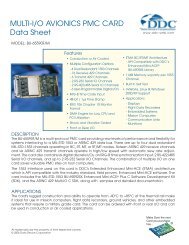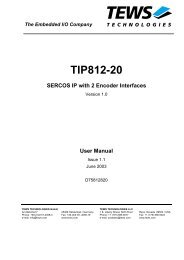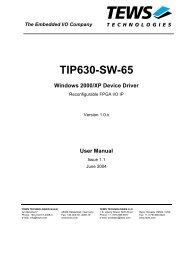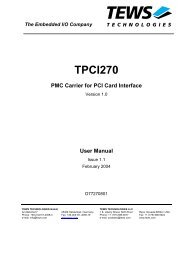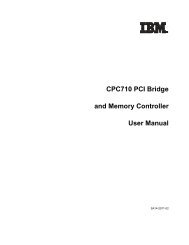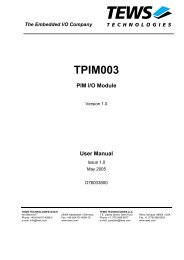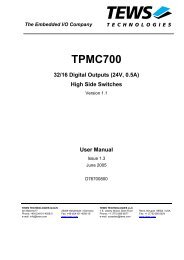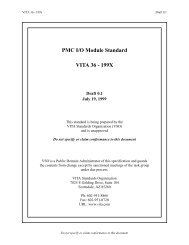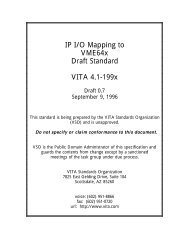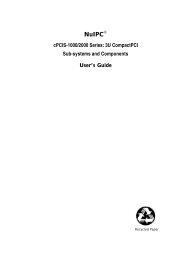MicroTCA TM - PICMG
MicroTCA TM - PICMG
MicroTCA TM - PICMG
You also want an ePaper? Increase the reach of your titles
YUMPU automatically turns print PDFs into web optimized ePapers that Google loves.
Not Intended for Design - Do not Claim Compliance<br />
Test Infrastructure<br />
An optional JTAG Switch Module (JSM) supports serial scan testing of complete <strong>MicroTCA</strong> Shelves, as well as<br />
their individual elements. This testing is most often carried out during manufacturing tests in a factory setting, but<br />
<strong>MicroTCA</strong> can also supports the use of these JTAG test capabilities in active systems in the field. JSM functions may<br />
be located in special slots on the backplane, or integrated into other Modules.<br />
Theory of operation<br />
<strong>MicroTCA</strong> works by providing the necessary infrastructure and interconnections to permit the AdvancedMC<br />
elements in a system to perform their intended functions. The MCH provides the management, clock, and fabric hub<br />
signals required by the AdvancedMC specification to each AdvancedMC position over the Backplane. Please refer<br />
back to Figure 1 during the following discussion of <strong>MicroTCA</strong> Shelf operation.<br />
The primary function of this <strong>MicroTCA</strong> system is to support the various types of AdvancedMCs that perform the<br />
system’s processing, storage, and I/O functions. The twelve AdvancedMC positions shown in Figure 1 can be<br />
populated with a diverse mix of AdvancedMC types. Conversely, it is possible to configure a <strong>MicroTCA</strong> system with<br />
only a single type of AdvancedMC. AdvancedMCs can include functionality that employs CPUs for control and<br />
feature processing, network processing units for packet processing and I/O, DSP AdvancedMCs for signal processing,<br />
storage AdvancedMCs, including built-in disk or flash storage, or interfaces to external storage arrays, and various<br />
I/O AdvancedMCs, such as subscriber lines, Ethernet, or optical networking.<br />
A set of common functions is needed to manage the AdvancedMCs, as shown in Figure 3. These functions are<br />
included in the MCH Module. They include a primary interconnect fabric to interconnect the high speed serial<br />
interfaces on AdvancedMCs, <strong>MicroTCA</strong> Carrier Management Controller (MCMC) and Carrier Manager functions to<br />
configure and control the elements, synchronization clocks, and JTAG test circuits. MCHs are optionally duplicated,<br />
permitting the creation of highly reliable systems.<br />
The switch fabric may support any of several protocols, as defined by the AdvancedMC subsidiary specifications<br />
that govern the complement of AdvancedMCs in a given <strong>MicroTCA</strong> Shelf. A PCI Express/Advanced Switching<br />
fabric supports AMC. 1, an Ethernet fabric supports AMC.2, a storage fabric switch supports AMC.3, and a serial<br />
RapidIO switch supports AMC.4. Other protocols for the switch fabric are possible.<br />
In addition to the MCH, a power infrastructure is required for a <strong>MicroTCA</strong> Carrier. Power is delivered to a <strong>MicroTCA</strong><br />
Shelf through either connections to AC mains voltage or to the +24, -48, or -60 V DC supplies typical of<br />
telecommunication installations. The Power Module produces the +12 V DC Payload Power required to operate the<br />
AdvancedMCs from the input voltage. The power control block splits, switches, distributes, and protects this +12 V<br />
source for the AdvancedMCs. The Power Module also produces, controls, and monitors multiple branches of +3.3 V<br />
Management Power for radial distribution to the AdvancedMCs, MCHs, PMs, and Cooling Units.<br />
Hot Swap support is another important function of the <strong>MicroTCA</strong> Carrier. Individual AdvancedMCs must be<br />
installed and removed from a <strong>MicroTCA</strong> Shelf without disrupting the operation of the other AdvancedMCs. Hot<br />
Swap functions on the PMs and Carrier Manager ensure that no damaging power transients occur as AdvancedMCs<br />
are inserted and withdrawn, and no disruptions hamper the operations of other AdvancedMCs that may share the same<br />
power infrastructure.<br />
A set of Cooling Units ensures that enough air is forced through the AdvancedMC, PM, and MCH air pathways to keep<br />
their temperature within a safe thermal envelope. These Cooling Units typically consist of several individual fans or<br />
blowers working in parallel to move an appropriate amount of air at the required pressure. Control systems in the Shelf<br />
Manager and Cooling Unit can dynamically adjust the fan speeds in order to provide enough cooling for the given<br />
environmental condition, minimizing component wear and acoustic noise.<br />
Fault tolerance and several redundancy options are supported in <strong>MicroTCA</strong>. Simple, inexpensive systems with less<br />
stringent availability requirements are often implemented as simplex Shelves with single MCHs and PMs. As more<br />
reliability is required, the common elements of a <strong>MicroTCA</strong> Shelf can be duplicated optionally, including a pair of<br />
<strong>PICMG</strong>® MTCA.0 Short Form Specification, September 21 st , 2006 9 of 34





